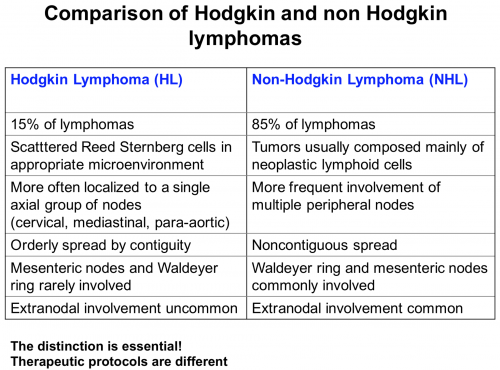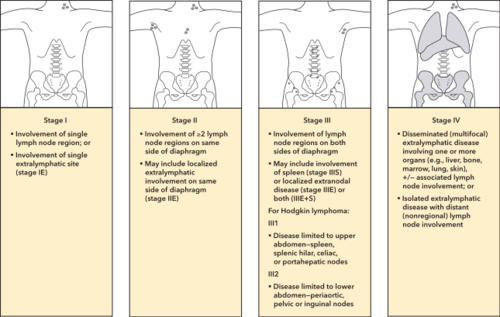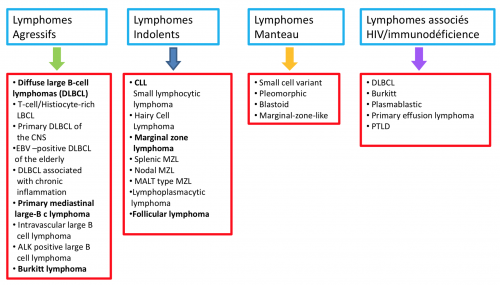Lymphomes
De médecine.top
Caractéristiques
- Clinique: lymphadénopathie
Staging
Classification de Ann Arbor
Lymphomes non-hodgkiniens
Lymphomes à cellules B
80-85% des lymphomes sont des lymphomes malins non-Hodgkiniens avec une large majorité de lymphomes B
Lymphome B à grandes cellules (DLBCL)
- Caractéristiques: Lymphome aggressif. 3 sous-types: lymphome « germinal center like », lymphome « Activate B cell », lymphome primaire du médiastin
- Clinique: Se présente avec une masse tumorale de croissance rapide
- Pronostic: basé sur score IPI[1] (5 paramètres)
- Age > 60 ans
- Stade III-IV
- Score performance ECOG (0-1 vs 2-4)
- LDH (>N)
- Sites extraganglionnaires (>1)
- Lymphomes à haut risque:
- IPI élevé
- Présence de deux réarrangements ("double hit") en particulier BCL-2 t(14;18) et MYC t(8;14)
- (Phénotype non germinal center)
- Traitement: Objectif curatif R-CHOP
- Si récidive: In addition to further standard chemotherapy, autologous HSCT and anti-CD19 chimeric antigen receptor (CAR) T-cell therapy may be used as salvage therapy in patients who relapse.
Lymphome du manteau
- Caractéristiques: Formes agressives et indolentes. Cellules lymphoïdes B issues cellules B "naïves" du manteau folliculaire
- Génétique: translocation t(11;14) → surexpression de la cycline D1 (diagnostic)
- Clinique: adénopathies, splénomégalie, atteinte muqueuse digestive
- Pronostic: très variable.
- Ki67 staining is recommended in the routine practice as a prognostic indicator[2].
- MCL International Prognostic Index (MIPI) is the prognostic model most often used and incorporates ECOG performance status, age, leukocyte count, and lactic dehydrogenase. A modification of the MIPI also adds the Ki-67 proliferative index if available[3]. Calcul: https://www.mdcalc.com/mantle-cell-lymphoma-international-prognostic-index-mipi
- Traitement: Objectif non curatif alternance R-CHOP et R-DHAP suivi d'une greffe autologue
- Si récidive/réfractaire: Ibrutinib (anti-BTK)
Lymphome de Burkitt
- Caractéristiques: Lymphome très aggressif. Association avec EBV (forme endémique ou associée à une immunodéficience) ou forme sporadique.
- Génétique: translocation t(8;14) → surexpression MYC
- Traitement: Objectif curatif avec guérison ~70 %
- Complications: syndrome de lyse tumorale
- Prophylaxis to manage tumor lysis syndrome should be instituted before initiation of chemotherapy for patients with Burkitt lymphoma: the most appropriate treatment is the administration of rasburicase along with intravenous hydration with normal saline and furosemide.
Lymphome B folliculaire
- Caractéristiques: Lymphome indolent. Progressions-rechutes toujours plus rapprochées sur une longue période. Follicular lymphomas are classified based on their dominant cell type: predominantly smaller cells (grade 1), a mixture of smaller and larger cells (grade 2), and predominantly large cells (grade 3).
- Génétique: translocation t(14;18) → surexpression de l'oncogène BCL2
- Pronostic: survie médiane ≥ 10 ans, risque de transformation en lymphome agressif → biopsie en cas de rechute ou transformation en lymphome diffus à grandes cellules B
- Score pronostique FLIPI 2
- Traitement: Objectif non curatif. Patients with nonbulky follicular lymphoma who are not symptomatic may survive many years without the need for therapy.
- Traitement d'induction suivi d'un traitement de maintenance par Rituximab
- Transformation en lymphome agressif: chimiothérapie de type R-CHOP (prise en charge comme un lymphome agressif)
Leucémie lymphoblastique chronique (LLC)
- Sujet traité sur la page Leucémies
Lymphome lymphocytaire
- Synonyme: small lymphocytic lymphoma
- Leucémie lymphoblastique chronique (LLC) and small lymphocytic lymphoma represent the same disease, with the designation as leukemia or lymphoma based on the dominant clinical manifestation in either peripheral blood and marrow or nodal involvement, respectively. Both CLL and small lymphocytic lymphoma are treated the same.
Hairy cell lymphoma
- Association avec polyartérite noueuse
Lymphome lymphoplasmocytaire
- Sujet traité sur la page Gammapathies monoclonales
Lymphomes à cellules T et à cellules NK
10-12% sont des lymphomes T ou NK Les lymphomes T les plus fréquents sont: Les lymphomes T périphériques NOS Les lymphomes T angioimmunoblastiques
- Seul les lymphomes T anaplasiques sont potentiellement curables en particulier les lymphome exprimant ALK
- Les lymphomes T ont un mauvais pronostic avec une survie globale à 5 ans de ≈ 30 %
- Traitement de première ligne > CHO(E)P
- Suivi si possible chez le sujet jeune d'une greffe de cellules souches hématopoïétiques auto ou allo
Lymphomes T périphériques NOS (not otherwise specified)
Lymphomes T angioimmunoblastiques (AILT)
Lymphome de Hodgkin
- Biopsie d'adénopathie: cellules de Reed-Sternberg
- The number of Reed-Sternberg cells and variability in the composition of the infiltrate lead to pathologic subtypes, including nodular sclerosis, mixed cellularity, lymphocyte predominant, and lymphocyte depleted.
- Moelle osseuse: non nécessaire, mais:
- A negative PET scan may obviate the need for bone marrow biopsies in many patients with Hodgkin and large cell lymphoma, but PET scans are not sensitive to very indolent lymphomas.
- Labo: Hyperferritinémie
- Traitement:
- All patients with classic Hodgkin lymphoma, regardless of stage, receive chemotherapy, usually the doxorubicin, bleomycin, vinblastine, and dacarbazine regimen


